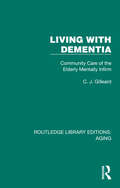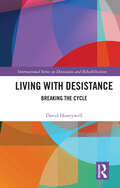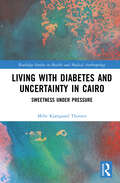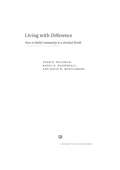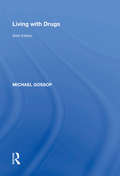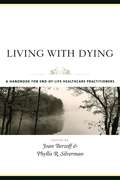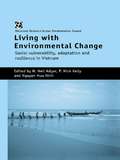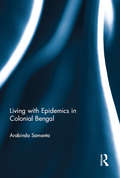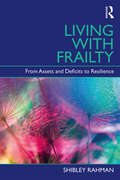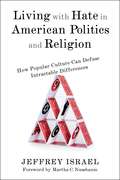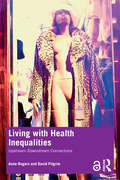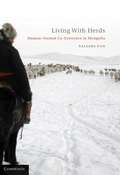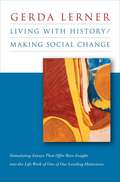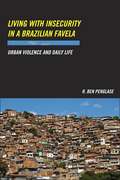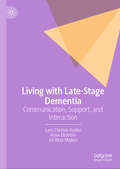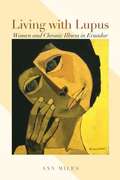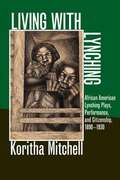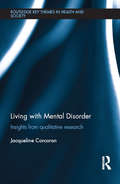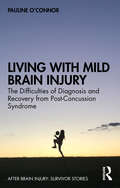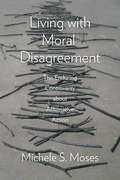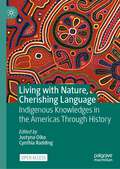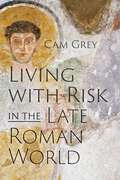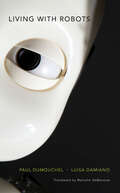- Table View
- List View
Living with Dementia: Community Care of the Elderly Mentally Infirm (Routledge Library Editions: Aging)
by C. J. GilleardIn the early 1980s, it had only recently been appreciated that what was known of the epidemiology of dementia in the elderly living in the community was just the tip of a large iceberg. Originally published in 1984, reissued here with a new preface, this book is concerned with presenting information on the nature of dementia, its prevalence and the existing pattern of services available at the time. It begins by considering the nature and epidemiology of dementia and examines the problems of supporting dementia sufferers for both families and professionals. Current services in the community are shown to be inadequate, and the division between hospital and community largely inappropriate. In conclusion the author proposes that radical changes to current service provision are necessary including the development of special day centres and residential units for dementia sufferers. Living with Dementia: Community Care of the Elderly Mentally Infirm addressed a topic of major importance and was an invaluable source of information for community nurses, psychiatrists, psychologists, geriatricians, general practitioners and social workers, all of whom encountered the problem. Today we can look back and reflect on what has changed.
Living with Desistance: Breaking the Cycle (International Series on Desistance and Rehabilitation)
by David HoneywellIn this new and distinctive contribution to the desistance literature, Dr David Honeywell draws on his own lived experience to consider his route through youth delinquency and prison to a life away from crime through education, and ultimately towards academia. Drawing on perspectives from criminology, sociology and psychology, this autoethnography offers a unique perspective to the desistance process and to social identity. Honeywell considers possible convergences as well as marked differences between the desistance and the convict criminology literatures. While desistance scholars have often emphasised the need for ex-offenders to cast off their criminal identities, Honeywell demonstrates how his own trajectory has involved him embracing this identity to develop an academic career. In doing so, this book emphasises the complexity of the desistance process, and the role of stigma, and also of hope. An accessible and compelling read, this book will appeal to students and scholars of criminology, sociology, psychology and those interested in the lived experience of desistance.
Living with Diabetes and Uncertainty in Cairo: Sweetness Under Pressure (Routledge Studies in Health and Medical Anthropology)
by Mille Kjærgaard ThorsenLiving with Diabetes and Uncertainty in Cairo offers an ethnographic exploration of the interactions of two different understandings of type-2 diabetes: one related to the notion of ḍaghṭ, translated as “pressure” or “stress,” and another related primarily to obesity. The book is set in Egypt but draws links to a diabetes clinic in Denmark and a multinational medical company, as well as engaging with international diabetes research and guidelines. It tells a story of uncertainty, not only among people in Cairo, but also within medical research, and considers what uncertainty may generate in both bodies and societies at large. The chapters provide valuable insight into the lives of those in Cairo who are diagnosed with type-2 diabetes, and explore how those lives are linked to global movements. The book ultimately reflects on the question of what is overlooked and why in prevention strategies and treatments of type-2 diabetes in Egypt. It will be of particular interest to scholars of anthropology, global and public health, and the Middle East and North Africa.
Living with Difference
by Adam B. Seligman David W. Montgomery Rahel R. WasserfallWhether looking at divided cities or working with populations on the margins of society, a growing number of engaged academics have reached out to communities around the world to address the practical problems of living with difference. This book explores the challenges and necessities of accommodating difference, however difficult and uncomfortable such accommodation may be. Drawing on fourteen years of theoretical insights and unique pedagogy, CEDAR--Communities Engaging with Difference and Religion--has worked internationally with community leaders, activists, and other partners to take the insights of anthropology out of the classroom and into the world. Rather than addressing conflict by emphasizing what is shared, Living with Difference argues for the centrality of difference in creating community, seeking ways not to overcome or deny differences but to live with and within them in a self-reflective space and practice. This volume also includes a manual for organizers to implement CEDAR's strategies in their own communities.
Living with Drugs
by Michael GossopNow in its sixth edition, Living with Drugs continues to be a well-respected and indispensable reference tool. Michael Gossop has updated this new edition to take account of new laws and practices that have come in to place since the previous edition, published in 2000. Written in an accessible style and providing a balanced perspective, the book is ideal for non-specialists in training, such as student nurses and social workers and for anyone with an interest in this complex, ever-present and emotive issue.
Living with Dying: A Handbook for End-of-Life Healthcare Practitioners (End-of-Life Care: A Series)
by Joan Berzoff Phyllis SilvermanThe first resource on end-of-life care for healthcare practitioners who work with the terminally ill and their families, Living with Dying begins with the narratives of five healthcare professionals, who, when faced with overwhelming personal losses altered their clinical practices and philosophies. The book provides ways to ensure a respectful death for individuals, families, groups, and communities and is organized around theoretical issues in loss, grief, and bereavement and around clinical practice with individuals, families, and groups. Living with Dying addresses practice with people who have specific illnesses such as AIDS, bone marrow disease, and cancer and pays special attention to patients who have been stigmatized by culture, ability, sexual orientation, age, race, or homelessness. The book includes content on trauma and developmental issues for children, adults, and the aging who are dying, and it addresses legal, ethical, spiritual, cultural, and social class issues as core factors in the assessment of and work with the dying. It explores interdisciplinary teamwork, supervision, and the organizational and financing contexts in which dying occurs. Current research in end-of-life care, ways to provide leadership in the field, and a call for compassion, insight, and respect for the dying makes this an indispensable resource for social workers, healthcare educators, administrators, consultants, advocates, and practitioners who work with the dying and their families.
Living with Environmental Change: Social Vulnerability, Adaptation and Resilience in Vietnam (Routledge Research In Global Environmental Change Ser. #No.6)
by W. Neil Adger P. Mick Kelly Nguyen Huu NinhVietnam and the neighbouring countries of Southeast Asia face diverse challenges created by the rapid evolution of their social, economic and environmental systems and resources. Taking a multidisciplinary perspective, this book provides a comprehensive assessment of the Vietnamese situation, identifying the factors shaping social vulnerability and resilience to environmental change and considering prospects for sustainable development.
Living with Epidemics in Colonial Bengal
by Arabinda SamantaMaking epidemics in colonial Bengal as its entry point and drawing heavily on social, cultural and linguistic anthropology to understand the functions of health experiences, distribution of illness, prevention of sickness, social relations of therapeutic intervention and employment of pluralistic medical systems, the book interrogates the social construction of medical knowledge, politics of science, and the changing paradigm of relationship between health of the individual and the prerogatives of larger colonial economic formations. Smallpox, plague, cholera and malaria which visited colonial Bengal with epidemic vengeance, caught the people unaware, killed them in thousands, and changed the society and its demographic structures. The book shows how sometimes through mutual adaptation but more often by cultural contestation, people pulled on with their microbial fellow travellers, and how illness became metaphor for the social dangers of improper code of conduct, to be corrected only through personal expropriation of the sin committed, or by community worship of the deity supposedly responsible for it. As a result, Western medical science was often relegated to the background, and elaborate rites and rituals, supposedly having curative values, came to the forefront and were observed with much community fanfare. Epidemics were also interpreted as outcome of politically incorrect moves made by the ruling power. To right the wrongs, people very often resorted to social protest. The protest by the literati went sometimes muted when its members seem to be beneficiaries of the colonial government, but it turned out to be all the more violent when the people, who had no private axe to grind, took up the cudgel to fight it out.
Living with Floods in a Mobile Southeast Asia: A Political Ecology of Vulnerability, Migration and Environmental Change (Routledge Studies in Development, Mobilities and Migration)
by Supang Chantavanich Carl Middleton Rebecca ElmhirstThis book contributes to a better understanding of the relationship between migration, vulnerability, resilience and social justice associated with flooding across diverse environmental, social and policy contexts in Southeast Asia. It challenges simple analyses of flooding as a singular driver of migration, and instead considers the ways in which floods figure in migration-based livelihoods and amongst already mobile populations. The book develops a conceptual framework based on a ‘mobile political ecology’ in which particular attention is paid to the multidimensionality, temporalities and geographies of vulnerability. Rather than simply emphasising the capacities (or lack thereof) of individuals and households, the focus is on identifying factors that instigate, manage and perpetuate vulnerable populations and places: these include the sociopolitical dynamics of floods, flood hazards and risky environments, migration and migrant-based livelihoods and the policy environments through which all of these take shape. The book is organised around a series of eight empirical urban and rural case studies from countries in Southeast Asia, where lives are marked by mobility and by floods associated with the region’s monsoonal climate. The concluding chapter synthesises the insights of the case studies, and suggests future policy directions. Together, the chapters highlight critical policy questions around the governance of migration, institutionalised disaster response strategies and broader development agendas.
Living with Frailty: From Assets and Deficits to Resilience
by Shibley RahmanIncreasingly, we question ‘what makes us healthy?’, as well as ‘what makes us ill?’. What does this shift mean for frailty? Almost wholly defined in negative terms, the term ‘frail’ tends to refer to a group of older people who are at highest risk of adverse outcomes such as falls, infections, disability, admission to hospital or the need for long-term care. This ground-breaking book takes a holistic approach to frailty. It connects the medical literature with the wider social science discourse on ageing, and focuses on promoting wellbeing and the building up of strengths. Living with Frailty draws together the latest biomedical evidence and good practice in this emerging area and explores ideas about assets and resilience, the role of society and the social model of disability in relation to frailty, arguing that insufficient attention is paid to positive action such as developing bone strength, maintaining good nutrition and exercising. Chapters look at: existing models of frailty person-centred care assessing frailty and quality of life how falls, and fear of falls, relate to discussions of frailty delirium and frailty the environment and frailty sarcopenia. Living with Frailty is an important introduction and reference for all practitioners, researchers and students with an interest in frailty, wellbeing and social approaches to health. Forewords by Professors Ken Rockwood, Dalhousie University, and Adam Gordon, Nottingham University.
Living with Hate in American Politics and Religion: How Popular Culture Can Defuse Intractable Differences
by Jeffrey IsraelIn the United States, people are deeply divided along lines of race, class, political party, gender, sexuality, and religion. Many believe that historical grievances must eventually be left behind in the interest of progress toward a more just and unified society. But too much in American history is unforgivable and cannot be forgotten. How then can we imagine a way to live together that does not expect people to let go of their entrenched resentments?Living with Hate in American Politics and Religion offers an innovative argument for the power of playfulness in popular culture to make our capacity for coexistence imaginable. Jeffrey Israel explores how people from different backgrounds can pursue justice together, even as they play with their divisive grudges, prejudices, and desires in their cultural lives. Israel calls on us to distinguish between what belongs in a raucous “domain of play” and what belongs in the domain of the political. He builds on the thought of John Rawls and Martha Nussbaum to defend the liberal tradition against challenges posed by Frantz Fanon from the left and Leo Strauss from the right. In provocative readings of Lenny Bruce’s stand-up comedy, Philip Roth’s Portnoy’s Complaint, and Norman Lear’s All in the Family, Israel argues that postwar Jewish American popular culture offers potent and fruitful examples of playing with fraught emotions. Living with Hate in American Politics and Religion is a powerful vision of what it means to live with others without forgiving or forgetting.
Living with Health Inequalities: Upstream–Downstream Connections
by David Pilgrim Anne RogersThis book explores how people encounter, understand, live with and respond to health risks associated with social, economic and political inequality. Complementing a traditional public health approach, the book moves beyond a focus on categories of morbidity and their structural causes. Instead, it focuses on everyday understandings and actions for people living in unequal social conditions. Making use of a variety of case studies related to physical and mental health, the authors emphasise interpersonal relationships, biographical meanings and the daily tactics of ‘getting by’. These are recurrently linked to the social-structural aspects of particular times and places. The book: Draws upon, applies and extends the biopsychosocial approach, which is well known to students of public health. Respects and gives due weight to the experience in context of people who live with health inequalities, in domestic and local settings. Explores notions of personal agency and the contingencies of everyday life, in order to offer a focused psycho-social compliment to a public health tradition dominated by top-down reasoning. This is an important read for all those seeking to understand the complexities of health inequalities holistically in their studies, research and practice. The book brings together thinking in the fields of public health, sociology, mental health and social policy.
Living with Health Inequalities: Upstream–Downstream Connections
by David Pilgrim Anne RogersThis book explores how people encounter, understand, live with and respond to health risks associated with social, economic and political inequality. Complementing a traditional public health approach, the book moves beyond a focus on categories of morbidity and their structural causes. Instead, it focuses on everyday understandings and actions for people living in unequal social conditions. Making use of a variety of case studies related to physical and mental health, the authors emphasise interpersonal relationships, biographical meanings and the daily tactics of ‘getting by’. These are recurrently linked to the social-structural aspects of particular times and places.The book: Draws upon, applies and extends the biopsychosocial approach, which is well known to students of public health. Respects and gives due weight to the experience in context of people who live with health inequalities, in domestic and local settings. Explores notions of personal agency and the contingencies of everyday life, in order to offer a focused psycho-social compliment to a public health tradition dominated by top-down reasoning. This is an important read for all those seeking to understand the complexities of health inequalities holistically in their studies, research and practice. The book brings together thinking in the fields of public health, sociology, mental health and social policy.The Open Access version of this book, available at http://www.taylorfrancis.com, has been made available under a Creative Commons [Attribution-Non Commercial-No Derivatives (CC-BY-NC-ND)] 4.0 license.
Living with Herds
by Natasha FijnDomestic animals have lived with humans for thousands of years and remain essential to the everyday lives of people throughout the world. In this book, Natasha Fijn examines the process of animal domestication in a study that blends biological and social anthropology, ethology, and ethnography. She examines the social behavior of humans and animals in a contemporary Mongolian herding society. After living with Mongolian herding families, Dr. Fijn has observed through firsthand experience both sides of the human-animal relationship. Examining their reciprocal social behavior and communication with one another, she demonstrates how herd animals influence Mongolian herders' lives and how the animals themselves are active partners in the domestication process.
Living with History / Making Social Change
by Gerda LernerThis stimulating collection of essays in an autobiographical framework spans the period from 1963 to the present. It encompasses Gerda Lerner's theoretical writing and her organizational work in transforming the history profession and in establishing Women's History as a mainstream field.Six of the twelve essays are new, written especially for this volume; the others have previously appeared in small journals or were originally presented as talks, and have been revised for this book. Several essays discuss feminist teaching and the problems of interpretation of autobiography and memoir for the reader and the historian. Lerner's reflections on feminism as a worldview, on the meaning of history writing, and on problems of aging lend this book unusual range and depth. Together, the essays illuminate how thought and action connected in Lerner's life, how the life she led before she became an academic affected the questions she addressed as a historian, and how the social and political struggles in which she engaged informed her thinking. Written in lucid, accessible prose, the essays will appeal to the general reader as well as to students at all levels. Living with History / Making Social Change offers rare insight into the life work of one of the leading historians of the United States.
Living with Insecurity in a Brazilian Favela
by R. Ben PenglaseThe residents of Caxambu, a squatter neighborhood in Rio de Janeiro, live in a state of insecurity as they face urban violence Living with Insecurity in a Brazilian Favela examines how inequality, racism, drug trafficking, police brutality, and gang activities affect the daily lives of the people of Caxambu. Some Brazilians see these communities, known as favelas, as centers of drug trafficking that exist beyond the control of the state and threaten the rest of the city. For other Brazilians, favelas are symbols of economic inequality and racial exclusion. Ben Penglase's ethnography goes beyond these perspectives to look at how the people of Caxambu themselves experience violence Although the favela is often seen as a war zone, the residents are linked to each other through bonds of kinship and friendship. In addition, residents often take pride in homes and public spaces that they have built and used over generations. Penglase notes that despite poverty, their lives are not completely defined by illegal violence or deprivation. He argues that urban violence and a larger context of inequality create a social world that is deeply contradictory and ambivalent. The unpredictability and instability of daily experiences result in disagreements and tensions, but the residents also experience their neighborhood as a place of social intimacy. As a result, the social world of the neighborhood is both a place of danger and safety.
Living with Late-Stage Dementia: Communication, Support, and Interaction
by Lars-Christer Hydén Anna Ekström Ali Reza MajlesiThis book investigates how people living with late-stage dementia can engage in communication and social interaction. Based on empirical research, it explores the remaining communicative resources of people living with cognitive impairment (e.g., intercorporeal interaction, bodily gestures, gaze), presenting the agency of the person with dementia as an integral part of their relations with others. The book provides a comprehensive theoretical framework for analyzing, describing, and understanding communication in late-stage dementia, and explores the use of video ethnography to record and analyze non-verbal, bodily interaction. The authors skilfully bring together findings from their examinations of everyday interactions involving individuals living with late-stage dementia in nursing facilities, introducing the readers to the innovative theoretical and methodological approaches that undergird the fine-grained analyses at the heart of the book. The rich and nuanced case studies collected encompass embodied directives, habitual actions and objects, physical settings, assisted eating, and much more. An invaluable resource for graduate students and researchers at all levels in the fields of psychology, psychotherapy, social work, nursing, gerontology, and related disciplines, this volume makes an unparalleled contribution to current dementia research across the social sciences.
Living with Lupus: Women and Chronic Illness in Ecuador
by Ann MilesOnce associated only with the wealthy and privileged in Latin America, lifelong illnesses are now emerging among a wider cross section of the population as an unfortunate consequence of growing urbanization and increased life expectancy. One of these diseases is the chronic autoimmune disorder lupus erythematosus. Difficult to diagnose and harder still to effectively manage, lupus challenges the very foundations of women's lives, their real and imagined futures, and their carefully constructed gendered identities. While the illness is validated by medical science, it is poorly understood by women, their families, and their communities, which creates multiple tensions as women attempt to make sense of an unpredictable, expensive, and culturally suspect medically managed illness. Living with Lupus vividly chronicles the struggles of Ecuadorian women as they come to terms with the experience of debilitating chronic illness. Drawing on years of ethnographic research, Ann Miles sensitively portrays the experiences and stories of Ecuadorian women who suffer with the intractable and stigmatizing disease. She uses in-depth case histories, rich in ethnographic detail, to explore not only how chronic illness can tear at the seams of women's precarious lives, but also how meanings are reconfigured when a biomedical illness category moves across a cultural landscape. One of the few books that deals with the meanings and experiences of chronic illness in the developing world, Living with Lupus contributes to our understanding of a significant global health transition. Once associated only with the wealthy and privileged in Latin America, lifelong illnesses are now emerging among a wider cross section of the population as an unfortunate consequence of growing urbanization and increased life expectancy. One of these diseases is the chronic autoimmune disorder lupus erythematosus. Difficult to diagnose and harder still to effectively manage, lupus challenges the very foundations of women's lives, their real and imagined futures, and their carefully constructed gendered identities. While the illness is validated by medical science, it is poorly understood by women, their families, and their communities, which creates multiple tensions as women attempt to make sense of an unpredictable, expensive, and culturally suspect medically managed illness. Living with Lupus vividly chronicles the struggles of Ecuadorian women as they come to terms with the experience of debilitating chronic illness. Drawing on years of ethnographic research, Ann Miles sensitively portrays the experiences and stories of Ecuadorian women who suffer with the intractable and stigmatizing disease. She uses in-depth case histories, rich in ethnographic detail, to explore not only how chronic illness can tear at the seams of women's precarious lives, but also how meanings are reconfigured when a biomedical illness category moves across a cultural landscape. One of the few books that deals with the meanings and experiences of chronic illness in the developing world, Living with Lupus contributes to our understanding of a significant global health transition.
Living with Lynching: African American Lynching Plays, Performance, and Citizenship, 1890-1930
by Koritha MitchellLiving with Lynching: African American Lynching Plays, Performance, and Citizenship, 1890-1930 demonstrates that popular lynching plays were mechanisms through which African American communities survived actual and photographic mob violence. Often available in periodicals, lynching plays were read aloud or acted out by black church members, schoolchildren, and families. Koritha Mitchell shows that African Americans performed and read the scripts in community settings to certify to each other that lynch victims were not the isolated brutes that dominant discourses made them out to be. Instead, the play scripts often described victims as honorable heads of household being torn from model domestic units by white violence. In closely analyzing the political and spiritual uses of black theatre during the Progressive Era, Mitchell demonstrates that audiences were shown affective ties in black families, a subject often erased in mainstream images of African Americans. Examining lynching plays as archival texts that embody and reflect broad networks of sociocultural activism and exchange in the lives of black Americans, Mitchell finds that audiences were rehearsing and improvising new ways of enduring in the face of widespread racial terrorism. Images of the black soldier, lawyer, mother, and wife helped readers assure each other that they were upstanding individuals who deserved the right to participate in national culture and politics. These powerful community coping efforts helped African Americans band together and withstand the nation's rejection of them as viable citizens.
Living with Mental Disorder: Insights from Qualitative Research (Routledge Key Themes in Health and Society)
by Jacqueline CorcoranThis evidence-based text puts a human face on mental disorders, illuminating the lived experience of people with mental health difficulties and their caregivers. Systematically reviewing the qualitative research conducted on living with a mental disorder, this text coalesces a large body of knowledge and centers on those disorders that have sufficient qualitative research to synthesize, including attention-deficit/hyperactivity disorder, autism, intellectual disabilities, mood disorders, schizophrenia and dementia. Supported by numerous quotes, the text explores the perspective of those suffering with a mental disorder and their caregivers, discovering their experience of burden, their understanding of and the meaning they give to their disorder, the strengths and coping they have used to manage, as well as their interactions with the formal treatment system and the use of medication. This book will be of immense value to students, practitioners, and academics that support, study, and treat people in mental distress and their families.
Living with Mild Brain Injury: The Difficulties of Diagnosis and Recovery from Post-Concussion Syndrome (After Brain Injury: Survivor Stories)
by Pauline O'ConnorThis important book presents a unique, personal account of the impact a mild traumatic brain injury can have. It tells the story of Pauline, who was 33 when a late football tackle caused a bleed in her brain which went undiscovered for 18 months. The account includes descriptions of hidden symptoms of concussion and post-concussion syndrome, pitfalls in diagnoses, the uneven progress of recovery and the effect of the varied reactions which others have to an acquired brain injury. The author incorporates memories alongside extracts from clinic notes, diary entries and emails to reflect the disjointed progress of diagnosis and recovery as- although similar- no two head injuries are the same. Through this book, the reader gains an appreciation of the confusion experienced by many brain injury survivors, which sheds light on why some may develop unusual behavior or mental health issues, and how such issues can be alleviated. Brain injuries are poorly understood by the general public and this can lead to difficult interactions. Moreover, complications in diagnosis means some may not realize they have this milder form of brain injury. This book will enlighten brain injury survivors and affected families and allow professionals an insight into their patients’ experiences. As concerns grow over the risks which contact sports pose, this book shows how even mild brain injuries can wreak havoc with careers, relationships and one’s sense of self, but that a happy life can still be found.
Living with Moral Disagreement: The Enduring Controversy about Affirmative Action
by Michele S. MosesHow to handle affirmative action is one of the most intractable policy problems of our era, touching on controversial issues such as race-consciousness and social justice. Much has been written both for and against affirmative action policies--especially within the realm of educational opportunity. In this book, philosopher Michele S. Moses offers a crucial new pathway for thinking about the debate surrounding educational affirmative action, one that holds up the debate itself as an important emblem of the democratic process. Central to Moses's analysis is the argument that we need to understand disagreements about affirmative action as inherently moral, products of conflicts between deeply held beliefs that shape differing opinions on what justice requires of education policy. As she shows, differing opinions on affirmative action result from different conceptual values, for instance, between being treated equally and being treated as an equal or between seeing race-consciousness as a pernicious political force or as a necessary variable in political equality. As Moses shows, although moral disagreements about race-conscious policies and similar issues are often seen as symptoms of dysfunctional politics, they in fact create rich opportunities for discussions about diversity that nourish democratic thought and life.
Living with Nature, Cherishing Language: Indigenous Knowledges in the Americas Through History
by Cynthia Radding Justyna OlkoThis open access book explores the deep connections between environment, language, and cultural integrity, with a focus on Indigenous peoples from early modern times to the present. It illustrates the close integration of nature and culture through historical processes of environmental change in North, Central, and South America and the nurturing of local knowledge through ancestral languages and oral traditions. This volume fills a unique space by bringing together the issues of environment, language and cultural integrity in Latin American historical and cultural spheres. It explores the reciprocal and necessary relations between language/culture and environment; how they can lead to sustainable practices; how environmental knowledge and sustainable practices toward the environment are reflected in local languages, local sources and local socio-cultural practices. The book combines interdisciplinary methods and initiates a dialogue among scientifically trained scholars and local communities to compare their perspectives on well-being in remote and recent historical periods and it will be of interest to students and scholars in fields including sociolinguistics, (ethno)history, linguistic anthropology, cultural studies and cultural anthropology, environmental studies and Indigenous/minority studies.
Living with Risk in the Late Roman World (Critical Studies in Risk and Disaster)
by Cam GreyExplores the ever-present experiences of risk that characterized the daily existence of individuals, communities, and societies in the late Roman worldLiving with Risk in the Late Roman World explores the ever-present experiences of risk that characterized the daily existence of individuals, communities, and societies in the late Roman world (late third century CE through mid-sixth century CE). Recognizing the vital role of human agency, author Cam Grey bases his argument on the concept of the riskscape: the collection of risks that constitute everyday lived experience, the human perception of those risks, and the actions that exploit, mitigate, or exacerbate them. In contrast to recent grand narratives of the fate of the late Roman Empire, Living with Risk in the Late Roman World focuses on the quotidian practices of mitigation and management, foreknowledge and prediction, and mobilization and manipulation of risks at the individual and community levels.Grey illustrates the ubiquity of these practices through a collection of anecdotes that emphasize the highly localized, heterogeneous, and complementary nature of riskscapes: members of local communities enlisting figures of power to neutralize the hazards posed by imminent catastrophes, be it a tsunami, earthquake, or volcanic eruption; Christian holy figures both suffering and imposing bodily affliction as part of their claims to control such hazards and thereby to exercise influence in these communities; intimate experiences of seasonality and weather that shaped local practices of subsistence but also of self-representation; and geographically specific and fiercely contested claims to special knowledge and control of water.Multidisciplinary in its methodology and provocative in its argumentation, Living with Risk in the Late Roman World demonstrates that human communities in the ancient past were inextricably intertwined with the world around them, and that the actions they took simultaneously responded to and shaped the risks—both hazardous and favorable—that they perceived.
Living with Robots
by Paul Dumouchel Luisa DamianoFrom artificial intelligence to artificial empathy, “a timely and well-written volume that addresses many contemporary and future moral questions” (Library Journal).Today’s robots engage with human beings in socially meaningful ways, as therapists, trainers, mediators, caregivers, and companions. Social robotics is grounded in artificial intelligence, but the field’s most probing questions explore the nature of the very real human emotions that social robots are designed to emulate.Social roboticists conduct their inquiries out of necessity—every robot they design incorporates and tests a number of hypotheses about human relationships. Paul Dumouchel and Luisa Damiano show that as roboticists become adept at programming artificial empathy into their creations, they are abandoning the conventional conception of human emotions as discrete, private, internal experiences. Rather, they are reconceiving emotions as a continuum between two actors who coordinate their affective behavior in real time. Rethinking the role of sociability in emotion has also led the field of social robotics to interrogate a number of human ethical assumptions, and to formulate a crucial political insight: there are simply no universal human characteristics for social robots to emulate. What we have instead is a plurality of actors, human and nonhuman, in noninterchangeable relationships.Foreshadowing an inflection point in human evolution, Living with Robots shows that for social robots to be effective, they must be attentive to human uniqueness and exercise a degree of social autonomy. More than mere automatons, they must become social actors, capable of modifying the rules that govern their interplay with humans.“A detailed tour of the philosophy of artificial intelligence (AI)?especially as it applies to robots intended to build social relationships with humanity. . . . If we are to build a robust, appropriate ethical structure around the next generation of technical development?some combination of deep learning, artificial intelligence, robotics and artificial empathy?we need to understand that managing the impact of these technologies is far too important to be left to those who are enthusiastically engaged in producing them.” —Times Higher Education
